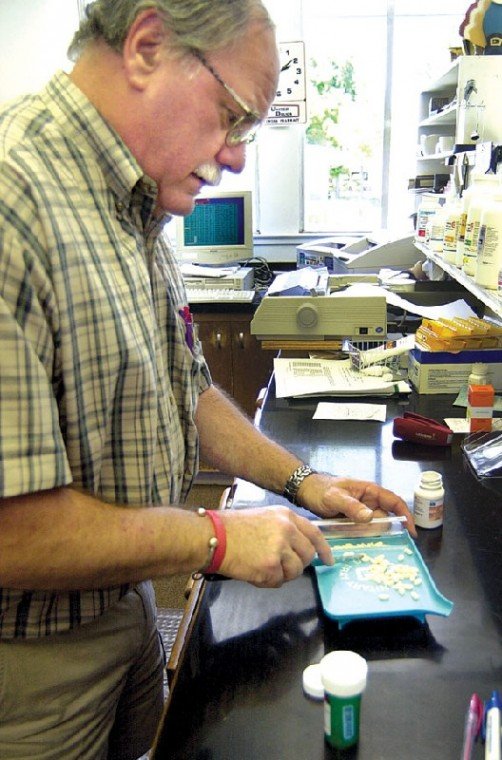Prescription-takers turn to Costco, other countries, to find
good deals on drugs
Gilroy – Seventy–five–year-old Harold Stevens takes between five and six medications each day for his epilepsy and the arthritis that has gnarled his hands. Most are covered by Kaiser and MediCal. But one is not.
A bottle of 150 pills costs him $114 every month.
“If I keep buying them every month I’m going to be bankrupt,” he said. “Prices keep going up and up and up.”
Stevens has searched area locations for lower prices. His friends have told him Costco sells drugs. He has heard of neighbors buying cheaper medicines over the telephone.
“I’ve even called Canada,” he said. “I’ve got to look out because I’m on a fixed income.”
Stevens believes Americans should be allowed to purchase prescription drugs legally from Canada. Either that, or the price should be lowered in the United States, he said.
But the door to cheaper prescription drugs may close this fall.
During a press conference last Wednesday, Canadian Health Minister Ujjal Dosanjh spoke of new legislation limiting large–scale sales of prescription exports to the U.S.
“Canada can no longer be the drugstore for the United States,” Dosanjh said. “In light of potential American legislation legalizing the bulk import of Canadian prescription and other medications, our priority must be the health and safety of all Canadians.”
But Stevens believes that even if Canada shuts the door on prescription drugs, another will open in the south.
“Everybody would just go to Mexico then,” he said. “A lot of people who live in San Diego just go over the border to get them.”
Just last month the Senate Health Committee passed Assembly Bill 73, which will provide information online about the prices of prescription drugs abroad.
President George W. Bush has introduced an overhaul of the Medicare system that includes a prescription drug benefit for about 42 million individuals. Low–income seniors are among those who qualify.
The president began promoting the plan in late June. Critics of the plan say its coverage is limited and leaves many seniors without aid.
Maria Diaz eats lunch at the Gilroy Senior Center every day. The Morgan Hill resident works part–time in Gilroy and budgets her monthly spending.
“(Medicare) sent me a note saying that I would have to pay a percentage next year,” she said. “They cover 100 percent, but I don’t know how much they’re going to pay … Sometimes I worry.”
Diaz has not thought too much about buying medications abroad – and isn’t sure she would.
She has no idea how much her three prescription medications would cost without Medicare, but she is certain of one thing: “They’re expensive.”
For seniors on a fixed income faced with the rising cost of health care premiums and prescription drugs, going north of the border may appear to be a viable option.
Garry L. Stutheit, owner of Gilroy Medical Pharmacy, sent an inquiry to Canada a few years ago to see how much he would save on his own prescriptions.
“You can save a lot by going to Canada,” he said.
In response, Stutheit received a list of more than 1,000 drugs he could purchase from pharmacies there. The downside to buying drugs outside the U.S. that aren’t made by American companies is that some may be unregulated and others may be a different color, Stutheit explained.
For some seniors who take multiple medications, many distinguish their pills by color.
When he notices a color change on the same drug, he places a fluorescent green warning label on the bottle so people will remember. Even so, Gilroy Medical Pharmacy still gets calls from confused customers.
“There’s no single answer to this,” he said. “I wish I could buy my drugs for what Canada pays for theirs. But that will never happen.”
U.S. pharmacies are not allowed to purchase drugs from Canada or abroad and then sell them for profit here.
“Hell, I could save $100 to $200 on drugs (bought in Canada.) It’s stupid. But that’s how it is,” he said.
Stutheit believes legislation that would lower the cost of prescription drugs sold in the U.S. needs to pass here.
“It’s not the ingredients (that make drugs expensive),” he said. “They say it’s for research. But the drug companies get more than their share.”
Stutheit has owned Gilroy Medical Pharmacy for about 25 years and has been dealing with drug companies and their representatives for long enough to know when prices are going to rise.
“You can almost predict it,” he said. “When allergy season hits then the allergy meds go up. And then they go up from there.”
Stutheit doesn’t see an end to the increase either. Each year, the cost of name brand prescription drugs has increased between 16 to 20 percent, he said.
While Stutheit understands the benefits of buying abroad, he cautioned those tempted to purchase prescription drugs by mail order.
“You just got to be careful about importing drugs – you don’t know where they’re coming from,” he said. “The huge majority are fine, but some you just don’t know.”
American pharmacies get recalls all the time because drugs are extremely regulated, Stutheit said. With mail ordered drugs, regulation is difficult.
“It’s just too big to keep track of,” Stutheit said. “I don’t know where they get their drugs from and I don’t think the government does either.”
He believes that mail ordering drugs could become a health issue.
“It’s a bad delivery system,” Stutheit said, holding up a carton with 15 different prescriptions in boxes. “This is one for one patient. Are you going to trust that to a mail order? It doesn’t promote health.”
Another problem: The actual method of delivery. Some drugs require specific temperatures to stay effective and others such as gel tabs may fuse in the heat, Stutheit said.
But the biggest problem with mail order medications is that the face-to-face patient contact is lost.
“If you don’t see the patient or talk to them, how do you know (how they’re doing?)” Stutheit asked. “You got to stop and talk to people – especially older people.”














